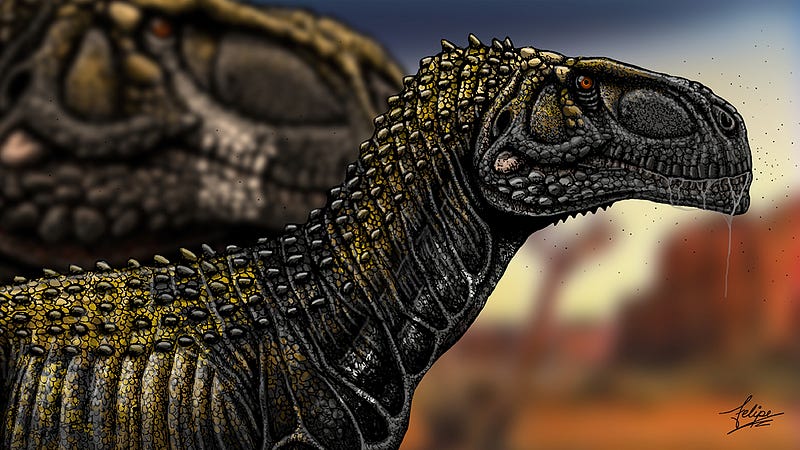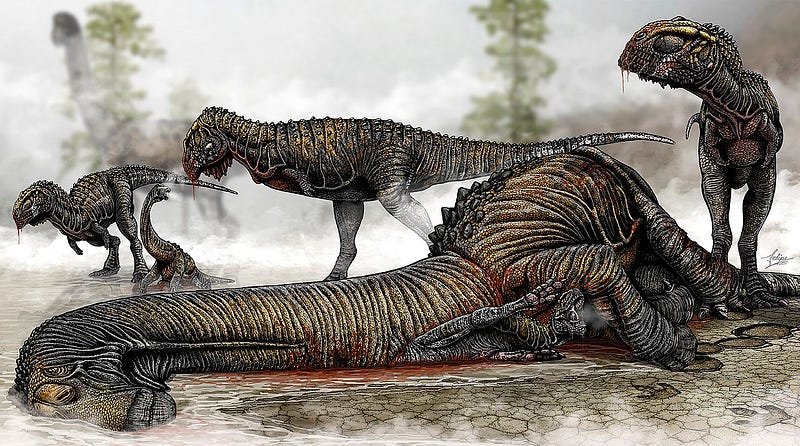The Sounds of Dinosaurs: What Did They Really Sound Like?
Written on
Chapter 1: A New Perspective on Dinosaur Vocalization
For a long time, the common belief has been that dinosaurs were fearsome creatures that roared. However, recent studies suggest that their vocalizations were more akin to those of modern birds. The discovery of the oldest preserved larynx from a non-avian dinosaur has revealed significant differences from both reptiles and birds. This fossil indicates that dinosaurs likely had the ability to produce a range of sounds, possibly even modulating them.

Imagine being transported back 80 million years to a forest that resembles today's Mongolia. Initially, all is silent, but then the gentle rustle of young trees signals the approach of a Pinacosaurus. This four-legged creature, not towering in height but extending several meters in length, moves gracefully through the underbrush. Its tail resembles a machete, and its back is armored with rows of spikes, while its rounded belly sways gently as it digests leaves.
As the Pinacosaurus chews its last few bites, it gazes in our direction and opens its mouth to make a sound. Our minds might picture a powerful roar, but what if that assumption is entirely incorrect? For decades, we imagined dinosaurs as massive, terrifying beasts whose roars echoed through ancient forests. Yet, recent evidence indicates a more nuanced reality. Some dinosaurs even had feathers, with vibrant colors that challenge our earlier perceptions.
Perhaps our understanding of the sounds these ancient reptiles produced should also be reconsidered. A recent study published in the journal Communications Biology details the structure of the first identified larynx of a non-avian dinosaur. Its unique anatomical features suggest that dinosaurs could have communicated in various ways, potentially even producing sounds similar to those of birds today.
Oldest Dinosaur Larynx: A Revolutionary Discovery
In 2005, paleontologists uncovered the remains of a Pinacosaurus grangeri in Mongolia, noting the exceptional preservation of its throat bones. Initially, these were thought to be relevant for respiration, but further investigation by Japanese and American scientists revealed that they are part of the dinosaur's larynx. Their analysis shows that the vocal organ of this dinosaur exhibited characteristics of both reptilian and avian larynges, making it a fascinating hybrid.

Understanding the Larynx Across Species
In reptiles and mammals, the larynx is positioned at the beginning of the pharynx, serving as a tube made of muscles, ligaments, and cartilage that produces sound. When air passes through, the vocal cords vibrate to create specific frequencies. Birds, on the other hand, have a lower larynx located at the end of their trachea, allowing them to produce complex sounds thanks to their unique vocal membranes. Some birds are capable of generating multiple sounds simultaneously, showcasing the intricate functionality of their vocal apparatus.
What Sounds Did Dinosaurs Make?
The Pinacosaurus's larynx contained elements similar to those of reptiles and mammals, such as annular and auricular cartilage, yet it was elongated, hinting at a possible ability to modulate sounds. Researchers speculate that these dinosaurs communicated frequently, possibly using sounds for courtship, calling their young, signaling danger, or deterring predators. While the exact nature of their vocalizations remains unknown, it’s conceivable they made chirps or noises reminiscent of modern parrots.
Victoria Arbour, a paleontologist not involved in the study, suggested that dinosaurs might have sounded similar to today's crocodiles, emitting deep growls. Regardless of the specifics, it’s clear that the Earth during the age of dinosaurs was filled with a cacophony of noises.
Chapter 2: Insights from Modern Science
The first video titled "What sounds did dinosaurs make? ft. Joe Hanson" explores the intriguing possibilities of dinosaur vocalizations, challenging preconceived notions about their sounds.
In the second video, "What Did Dinosaurs Really Sound Like? Could Dinosaurs Sing Like Birds? New Science Says Maybe!" dives into the latest scientific insights regarding the sounds these ancient creatures may have produced.
Giant Dinosaur-Era Insect Rediscovered in the US
In the 1950s, a researcher misclassified an insect that was later rediscovered, shedding light on the fascinating biodiversity of the dinosaur era.
Thanks for reading this article! If you found it informative, please consider leaving some feedback or even a tip to show your appreciation. Your support means a lot!